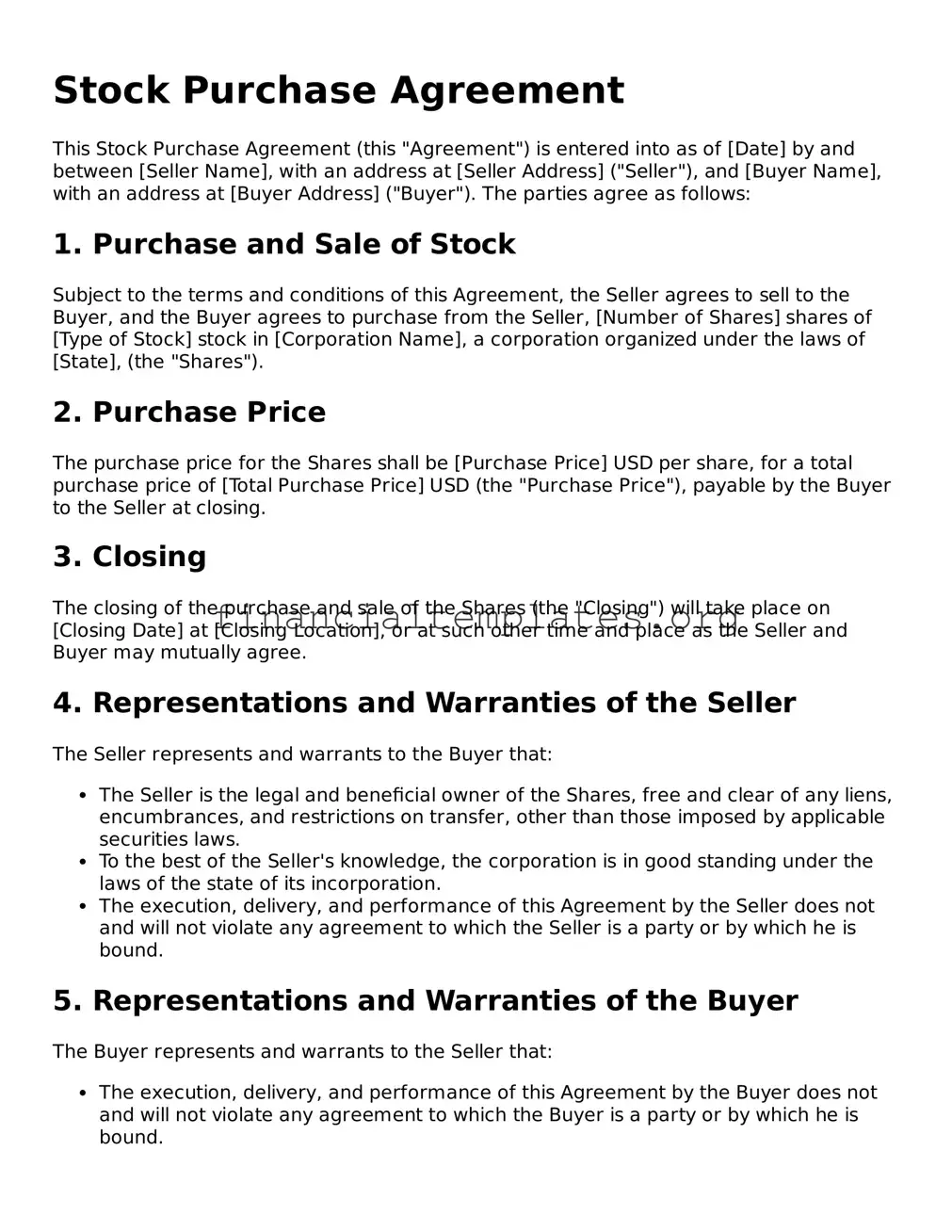Stock Purchase Agreement
This Stock Purchase Agreement (this "Agreement") is entered into as of [Date] by and between [Seller Name], with an address at [Seller Address] ("Seller"), and [Buyer Name], with an address at [Buyer Address] ("Buyer"). The parties agree as follows:
1. Purchase and Sale of Stock
Subject to the terms and conditions of this Agreement, the Seller agrees to sell to the Buyer, and the Buyer agrees to purchase from the Seller, [Number of Shares] shares of [Type of Stock] stock in [Corporation Name], a corporation organized under the laws of [State], (the "Shares").
2. Purchase Price
The purchase price for the Shares shall be [Purchase Price] USD per share, for a total purchase price of [Total Purchase Price] USD (the "Purchase Price"), payable by the Buyer to the Seller at closing.
3. Closing
The closing of the purchase and sale of the Shares (the "Closing") will take place on [Closing Date] at [Closing Location], or at such other time and place as the Seller and Buyer may mutually agree.
4. Representations and Warranties of the Seller
The Seller represents and warrants to the Buyer that:
- The Seller is the legal and beneficial owner of the Shares, free and clear of any liens, encumbrances, and restrictions on transfer, other than those imposed by applicable securities laws.
- To the best of the Seller's knowledge, the corporation is in good standing under the laws of the state of its incorporation.
- The execution, delivery, and performance of this Agreement by the Seller does not and will not violate any agreement to which the Seller is a party or by which he is bound.
5. Representations and Warranties of the Buyer
The Buyer represents and warrants to the Seller that:
- The execution, delivery, and performance of this Agreement by the Buyer does not and will not violate any agreement to which the Buyer is a party or by which he is bound.
- The Buyer is purchasing the Shares for investment for his own account, and not with a view to, or for resale in connection with, any distribution or public offering of the Shares within the meaning of any applicable securities laws.
6. Governing Law
This Agreement shall be governed by and construed in accordance with the laws of the State of [Governing Law State], without regard to its conflict of law principles.
7. Entire Agreement
This Agreement constitutes the entire agreement between the parties with respect to the subject matter hereof and supersedes all prior agreements and understandings, both oral and written, between the parties with respect to the subject matter hereof.
8. Amendment
This Agreement may be amended only by a written agreement executed by both parties.
9. Notices
All notices required or permitted under this Agreement shall be in writing and shall be deemed effectively given upon delivery by hand, by certified mail, return receipt requested, or by overnight courier, to the addresses set forth at the beginning of this Agreement, or to such other addresses as the parties may later designate in writing.
10. Counterparts
This Agreement may be executed in counterparts, each of which shall be deemed an original, but all of which together shall constitute one and the same instrument.
IN WITNESS WHEREOF, the parties hereto have executed this Stock Purchase Agreement as of the date first above written.
Seller Signature: _____________________ Date: _______________
Buyer Signature: _____________________ Date: _______________
